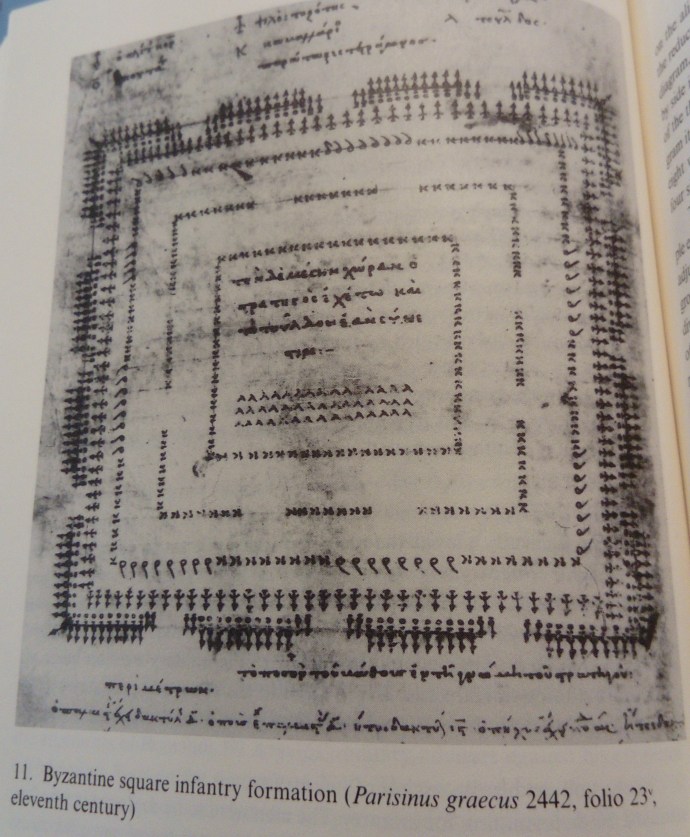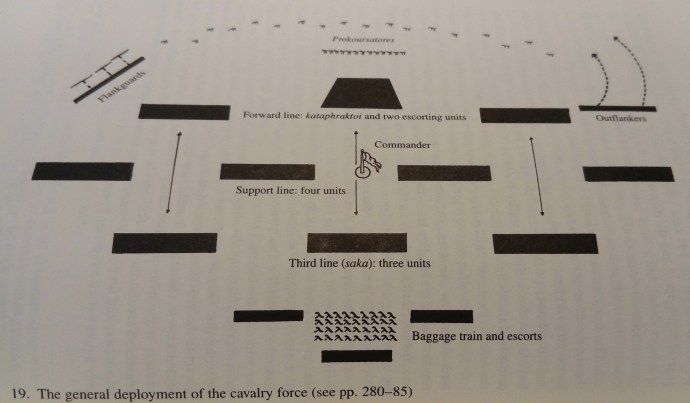
Reinforced infantry anticipating an attack and closing the gaps (from Sowing the Dragon’s Teeth by Eric McGeer)
An interview with Eric McGeer about his book “Sowing the Dragon’s Teeth” which charts the changes in the Roman army as it moved to an offensive deployment in the 10th century.
Period: 10th century
Download: Sowing the Dragon’s Teeth with Eric McGeer
RSS Feed: The History of Byzantium
If you want to send in feedback to the podcast:
– Either comment on this post.
– Or on the facebook page.
– Leave a review on Itunes.
– Follow me on Twitter.




One of the best episodes yet! I can only imagine what it must have felt like for a cataphract to wear that armor in Syria during summer. Does the book estimate the dimensions of a 15 to 20,000 person square?
I will have a look…
I can’t find a reference to that I’m afraid. It would obviously have required a huge amount of space. But I doubt that the whole army were all together in one square very often.
Great episode, I love the interviews as they add a level of depth to an already amazing podcast and great period of history. With regards to structure and command of the armies, In previous episodes you mentioned that the Armies were split into east and west commands. When campaigning especially in the east would i be wrong to assume that the armies followed a similar structure to the legion system, that when on campaign would take several themes and could act independently if needed to for full a special role or task?
My understanding is that a General campaigning in the east would call up men to a designated spot. Often Caesarea in Cappadocia. And then pick the men he wanted for that particular campaign. Hence the need for a manual that explained who to choose, how to train them and how they should form up.
I assume if a second army was going to raid in a different area of the frontier then a similar process would take place. So Nicephorus would choose his troops and take them off in one direction. Meanwhile John Tzimisces (for example) would call up a different group of soldiers and pick and train his own army. Then head off on campaign.
Within those armies the commander might choose to split off a portion and send them off to perform a specific task. And perhaps in that case he might choose a group of men from the same Theme. But I don’t think Theme troops within an army group were expected to act independently. Cohesion was key to success.
Great episode and series. Given we are now in the thick of the Byzantine reconquest, will you have a special episode of the Byzantine Epic, Digenis Akritas and the enormous Akritic Cycle corpus. Although, probably written down a few centuries later, its content was developed during this era. And although it is obviously poetic in nature, it does provide insights into the conditions of the Eastern Frontier and the aspirations and fears of the Byzantine border solders or Akritai.
https://en.wikipedia.org/wiki/Acritic_songs
https://en.wikipedia.org/wiki/Digenes_Akritas
Interestingly, many modern day Greek groups such as Pontian and Cypriot Greeks still sings songs that celebrate Digenis Akritas, Andronikos, Armouris etc.
I will definitely talk about it 🙂
Great episode and great podcast in general! keep up the good work. Not related to the current podcast but something I just stumbled on the spread of Byzantine artifacts across the old world with nice pictures :
http://www.caitlingreen.org/2017/03/a-very-long-way-from-home.html
Wonderful interview. I too say “YES!” the Kataphrakoi”. I cannot say enough about Professor McGeer’s book “Sowing the Dragons Teeth”. His description of the Byzantine armored cavalry wedge in action will make every military history devotee stand up and salute. This may sound clichéd, but I wish I could be transported back in time and watch this formation be unleashed on the battlefield, and witness the impact of the armored arrow formation with the enemy’s line stationed in front of its commander.
What an extremely violent spectacle it would be: Kataphraktoi protected by their mail aventail and halberk plus interlaced lamillar cuirass methodically closing the distance on their armored steeds; Maces slammed down on skulls; flights of arrows erupting from within the wedge formation dropping like a curtain barrage – the whole visual scene. All I can say is get Professor McGeer’s book.
A canter instead of a charge gives the cataphracts more time to stop themselves if there’s a development, such as a defile trap. A slower speed of impact also reduces the impact of the opposing spearheads against them through Newton’s Third. One can imagine that a penetrating blow at higher speeds could deflect off at lower speeds.
Just wanted to say – this was a marvelously edited and conducted interview! Great information, great pacing, great highlights. Home run, work of art.
You probubly said in the episode but I tried and failed to find this. When you say the army was in a massive square do you mean the individual units were in a square or that the entire army was in a square? Thanks for a fantastic podcast!
The whole army was deployed in a square. Individual units were in lines as you would expect.
Great episode. The walking fortress formation sounds formidable but one question immediately sprang to mind… when marching through mountainous or uneven terrain, where such a wide formation would be hard or impossible to maintain, how did they reconfigure?
One other question… do we know what prayer it was that the kataphraktoi prayed before setting into motion?
I don’t think they would have been in formation except when marching through open country. I’m not sure about the prayer, I’d have to look into it
I got chills during the part where he describes step by step the initial appearances and growth in tactical supremacy of the cataphracts… the first appearance of the cataphracts as a failure, but then the attack in 965 where things got more like clockwork, in a wedge formation combined with archers, etc… wow. I would say this interview is a “work of art,” but your other fans have beat me to the punch.
Just a thought, though–maybe you could add the unedited version of the interview as part of the bonuses for your subscribers? I’d like to re-listen later without the commentary.
Hey! One note- the ad at the end of this episode cuts off the interview mid-sentence.
Thank you for all the work all these years!
Thank you for letting me know. When I download the episode it seems to be ok. Do you remember if you were streaming it?